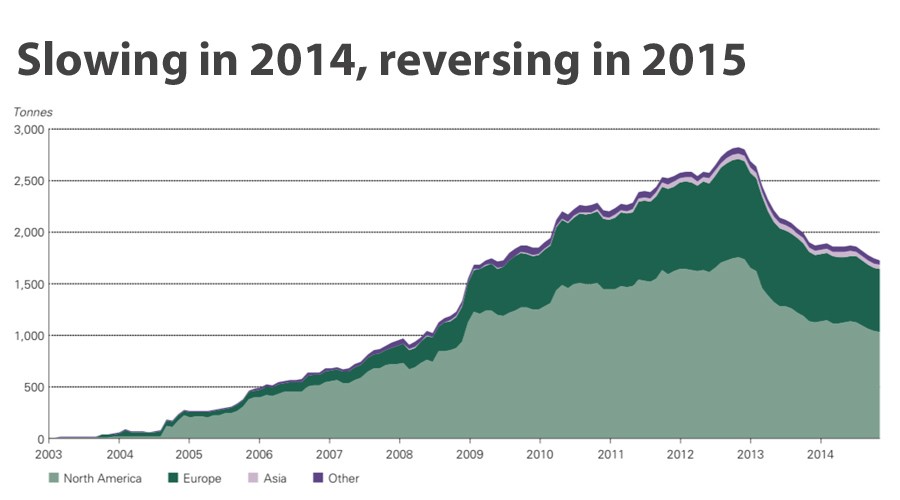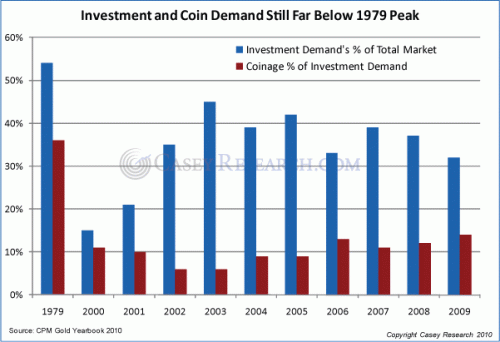ETF and central bank buyers storm gold market
Post on: 21 Май, 2015 No Comment

Still flowing
Still flowing
The World Gold Council’s annual demand trends study for 2014 shows a year of painful readjustment and rebalancing for the gold market after a record-breaking 2013.
Overall demand slipped 4% to 3,923 tonnes last year with jewellery demand falling 10% to 2,253 tonnes compared to 2013. Technology demand continued its long-term decline, dropping to an 11-year low in 2014.
On the flip side central bank purchases jumped close to a 50-year high of 477 tonnes while net investment demand managed to eke out gains of 2% for a total of 904.6 tonnes during the year.
Juan Carlos Artigas, Director of Investment Research at the WGC, cautions however that the positive year-on-year comparison was not necessarily driven by an improvement in investor sentiment, but rather by a slowdown in outflows.
The report shows annual outflows from gold-backed ETFs turned into a 159t trickle from the 880t torrent in 2013 in no small part due to the strength of the US dollar, continued improvement in the world’s largest economy and the relatively stable gold price environment.
January this year has seen a turnaround with gold-backed ETFs recording inflows of roughly 60 tonnes. With reservations about the health of the global economy coupled with uncertainty about central banks and monetary policy, it is understandable that gold would attract more investment interest as a storer of wealth, says Artigas, who is based in New York.
Redemptions in Europe were also heavily concentrated among Swiss ETFs, but UK and German ETFs already experienced net inflows last year, says Artigas.
Artigas also points out that thanks to the relative size of its industry, outflows from gold-backed ETFs in the US of more than 100t skewed the overall picture last year. January’s trend reversal also came from US buyers.
More than half of these outflows occurred in the final quarter of the year, perhaps not surprisingly: the price drop in late October/ early November would likely have contributed to investors closing out of positions.
Because it is transparent and can be tracked on a daily basis gold-backed ETFs gets a lot of attention, but the industry still constitutes only around 8% of demand since inception little over a decade ago.
Bars and coins still represent some two-thirds of investment demand, says Artigas. After a truly exceptional 2013 that saw phenomenal levels of buying demand for bar and coins among smaller investors, 2014 saw demand drop by an eye-watering 40%.

Investors, whose holdings were already inflated after the previous year’s burst of bargain-hunting, were disenchanted by the lack of a clear trend in the gold price: expectations were consequently revised downward in several markets led by China, where demand halved.
Artigas points out that investors put money into ETFs and bars and coins for the same reasons: If the preferred investment vehicle for Chinese investors were ETFs, 2013 may not have seen the vast outflows it did.
Total investment demand – a measure that includes a number of less visible elements – showed a rise of 18% to 1,259t from 1,071t in 2013, driven by a big jump in the opaque over-the-counter trade. This investment measure also includes gold deposit accounts and stock flows that have yet to be allocated at the country level.
While the demand picture fell back from 2013, supply stayed strong during 2014. Last year miners produced gold at a record setting pace of 3,114 tonnes, but overall supply was static thanks to 140t fewer tonnes of recycled gold reaching the market.
Gold recycling reached a seven-year low last year while mine supply has been growing by an average 4.7% per year since 2008.
Source: WGC
Image of gold pour at Gold Reef City in Johannesburg, South Africa by Dan Brown .














